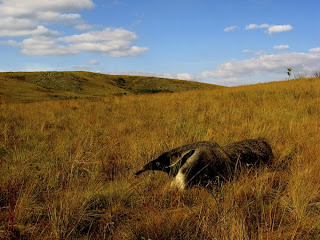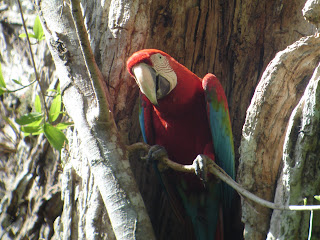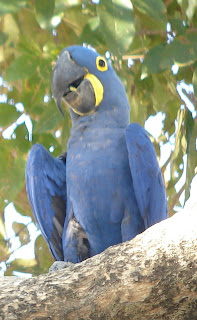CLASSIC BRAZIL – Atlantic Forests, The Pantanal & Cerrado.
Dates: 19 September – 2 October 2009 (from Rio de Janeiro).
Group size: Limited to 8 participants.
Price: £2790.00 from Rio de Janeiro.
Single room supplement: £310.00.
Includes: All transportation and transfers with the group in Brazil, accommodation from day 1 to the night of day 14, all meals from dinner day 1 to breakfast day 15, services of Toucan Birding Tours leader and local guides, gratuities to local guides, drivers.
Not included: International airfare, airport departure tax, beverages with meals, drinks (water will be available on the bus), and gratuities to hotel staff, phone calls, and items of a personal nature.
Tour Leader: Colin Bushell.
ITINERARY.
Day 1. Arrival at Rio de Janeiro International Airport (GIG) where we’ll be met and taken to Guapi Assu Bird Lodge (REGUA).
Days 2 -3. Two full days at REGUA (Guapi Assu): Spot-billed Toucanet, Spot-breasted Antvireo, Star-throated Antwren, Scaled Antbird, Black-cheeked Gnateater, Blue (Swallow-tailed) Manakin, Eye-ringed Tody Flycatcher, Yellow-lored Tody Flycatcher, Grey-hooded Attila, Red-necked, Golden-chevroned, Green-headed Tanager, Black-throated Grosbeak, Bare-throated Bellbird, Mantled Hawk, Greenish Schiffornis, Pin-tailed Manakin, Rufous-breasted Leaftosser, Giant Antshrike, Large-tailed Antshrike, Crescent-chested Puffbird, Surucua Trogon and Russet-winged Spadebill could all be seen during our stay here. Excursions away from the reserve may produce Black-and-Gold Cotinga or Three-toed Jacamar and we’ll be hoping to locate an Elegant Mourner on the reserve, as Guapi Assu is undoubtedly one of the best sites for this scarce species in the Neotropics. All nights at the Guapi Assu Bird Lodge (REGUA).
Day 4. Early birding at REGUA's wetland for Giant Snipe and Masked Duck. After breakfast we’ll leave for Itatiaia National Park, arriving in time for some birding near the hotel. Overnight in Itatiaia.
Days 5 & 6. Itatiaia for Black & Gold Cotinga, Rufous-tailed Antbird, Brazilian Antthrush, Rufous-backed Antvireo, Black-capped Piprites, Black-breasted Plovercrest, Itatiaia Spinetail, Shear-tailed Grey Tyrant, Velvety-black Tyrant, Serra do Mar Tyrant-Manakin, Serra do Mar Tyrannulet, Brown-breasted Bamboo-Tyrant, Araucaria Tit-Spinetail, Brassy-breasted and Diademed Tanager, Great Pampa-Finch, Mouse-coloured Tapaculo, Slaty-breasted Wood-Rail, White-bearded Antshrike, Fork-tailed Bamboo-Tyrant, Giant, and Tufted Antshrikes, Cryptic Antthrush, White-bibbed, Ferruginous, Bertoni's and Ochre-rumped Antbirds, Saffron Toucanet, Channel- billed Toucan, White-browed and Green-barred Woodpeckers, Dusky-legged Guan, Rufous-tailed and Grey-hooded Attilas, Golden-chevroned, Green-headed, Magpie, Chestnut-headed and Rufous-headed Tanagers and Planalto Woodcreeper. Tawny-browed Owl can often be found after dark on a trail near our hotel. Hummingbird feeders will be observed to see the incredible show of gems visiting them including Black Jacobin, Frilled Coquette, Violet-capped Woodnymph, Brazilian Ruby, Glittering-throated and Vesicolored Emerald and Scaly-throated Hermit. All nights in Itatiaia.
Day 7. We’ll leave Itatiaia today transferring to Rio de Janeiro airport for our flight to Cuiaba in Mato Grosso. Overnight Cuiaba.
Day 8. Cuiaba - Southern Screamer, Brazilian Teal, Muscovy Duck, Jabirus, Roseate Spoonbill, Plumbeous Ibis, White Woodpeckers, Hyacinth Macaw, Chotoy and Yellow-chinned Spinetails, Scarlet-headed Blackbird and Tropical Screech-Owl or Great Horned Owl in the evening.
Day 9. Morning birding near the lodge for Great Rufous Woodcreeper, Grey-crested Cachalote. Greater Rheas, Maguari Stork, Sunbittern, Green-backed Becard, Blue-crowned Trogon, Rufous-tailed Jacamar, Pale-crested Woodpecker, Planalto Woodcreeper, Rufous Casiornis, Planalto Slaty-Antshrike and Chestnut-vented Conebill.
Days 10 & 11. Using our comfortable lodge as a base for the next two nights we’ll explore gallery forest on foot and take a boat ride along the Rio Pixaim. Black-collared Hawk, Sungrebe, Rusty-backed Spinetail, Mato Grosso Antbird, Rusty-fronted Tody-Flycatcher, Helmeted Manakin, Red-billed Scythebill, Large-billed Antwren, Fawn-breasted Wren, Band-tailed Antbird or maybe an American Pygmy-Kingfisher. Toco Toucan, Rufous Cachalote, Golden-collard Macaw, Black-hooded Parakeet, Green & Rufous Kingfisher whilst Giant Otters are a distinct possibility here (we have seen them on our previous three visits).
Day 12. Pantanal - Chapada dos Guimaraes for Blue-winged and Red & Green Macaws as well as Great Dusky Swift, Biscutate Swift, etc. Overnight in Chapada.
Day 13. A full day to explore the Cerrado and woodlands near Chapada for White-eared Puffbird, Curl-crested Jay, Grey Monjita, Rufous-winged Antshrike, White-rumped and White-banded Tanagers, Black-throated Saltator, Coal-crested Finch, Blue Finch, Collared Crescentchest, Horned Sungem, Rufous-sided Pygmy-Tyrant, Cinnamon-throated Hermit, Yellow-ridged Toucan, Lettered Aracari, Blue-crowned Motmot, Ochre-cheeked Spinetail, Plain Antvireo, Southern Antpipit, Sirystes, Fiery-capped and Band-tailed Manakins, Planalto Tyrannulet, White-lined, Guira & Grey-headed Tanagers, Pectoral Sparrow and Sharp-tailed Streamcreeper. Overnight in Chapada.
Day 14. This morning we’ll take the short journey back to Cuiaba for our flights to Rio de Janeiro (GIG) or Sao Paulo (GRU) to connect with homebound international departures.


 Safari Brazil August 2009: We'll be visiting Canastra National Park, Caraca, Cipo and Linhares in search of Brazilian Merganser, Banded Cotinga, Swallow-tailed Cotinga and we've a great chance to see Maned Wolf and Giant Anteater too. See below for details.
Safari Brazil August 2009: We'll be visiting Canastra National Park, Caraca, Cipo and Linhares in search of Brazilian Merganser, Banded Cotinga, Swallow-tailed Cotinga and we've a great chance to see Maned Wolf and Giant Anteater too. See below for details.+066.JPG)
+003.JPG)
+001.JPG)





 Images from November's Atlantic Forest Endemics Tour: (from top) Stymphalornis antwren sp. (female); REGUA wetland; Tropical Screech-Owl; Bare-throated Bellbird; Swallow-tailed Cotinga; Atlantic Rainforest (Intervales State Park); Masked Duck (female); Three-toed Jacamar; Frilled Coquette.
Images from November's Atlantic Forest Endemics Tour: (from top) Stymphalornis antwren sp. (female); REGUA wetland; Tropical Screech-Owl; Bare-throated Bellbird; Swallow-tailed Cotinga; Atlantic Rainforest (Intervales State Park); Masked Duck (female); Three-toed Jacamar; Frilled Coquette. +064.JPG)


































.jpg) Latest tour news: BRAZIL 2009 (full details on
Latest tour news: BRAZIL 2009 (full details on 

